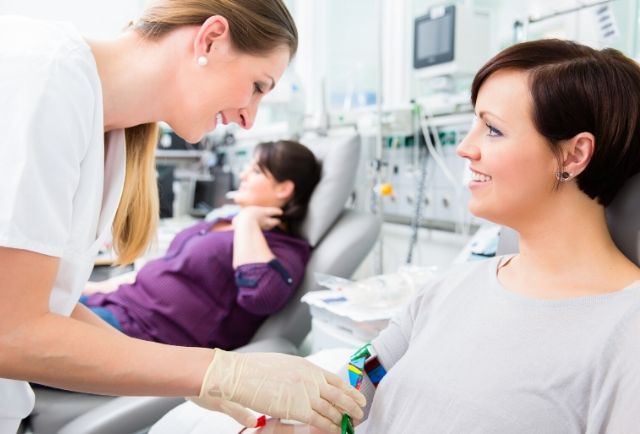Our Northeast Medical Institute - New Haven Campus Phlebotomy Course & Cna Class Diaries
Table of ContentsWhat Does Northeast Medical Institute - New Haven Campus Phlebotomy Course & Cna Class Do?Getting The Northeast Medical Institute - New Haven Campus Phlebotomy Course & Cna Class To WorkHow Northeast Medical Institute - New Haven Campus Phlebotomy Course & Cna Class can Save You Time, Stress, and Money.6 Easy Facts About Northeast Medical Institute - New Haven Campus Phlebotomy Course & Cna Class ExplainedHow Northeast Medical Institute - New Haven Campus Phlebotomy Course & Cna Class can Save You Time, Stress, and Money.The Single Strategy To Use For Northeast Medical Institute - New Haven Campus Phlebotomy Course & Cna Class
The use of such tools should be accompanied by various other infection avoidance and control methods, and training in their usage. Not all security gadgets apply to phlebotomy. Before picking a safety-engineered gadget, individuals must thoroughly explore offered gadgets to establish their appropriate usage, compatibility with existing phlebotomy practices, and effectiveness in protecting staff and patients (12, 33).For settings with low resources, cost is a driving consider purchase of safety-engineered gadgets - CNA Classes. Where safety-engineered tools are not offered, experienced use of a needle and syringe is appropriate. Accidental direct exposure and certain info concerning an occurrence should be taped in a register. Assistance solutions should be promoted for those who undertake unintended direct exposure.
One of the vital markers of high quality of care in phlebotomy is the participation and participation of the client; this is equally helpful to both the health worker and the client. Clear details either composed or verbal must be offered to each client that goes through phlebotomy. Annex F gives example text for explaining the blood-sampling treatment to a client. In the blood-sampling area for an outpatient division or clinic, offer a comfortable reclining sofa with an arm rest.
Northeast Medical Institute - New Haven Campus Phlebotomy Course & Cna Class Fundamentals Explained
Ensure that the signs for blood tasting are plainly specified, either in a written protocol or in documented instructions (e.g. in a research laboratory form). In all times, follow the techniques for infection avoidance and control provided in Table 2.2. Infection prevention and control techniques. Gather all the devices required for the treatment and location it within secure and easy reach on a tray or cart, making certain that all the things are clearly visible.
Where the client is grown-up and conscious, follow the steps described below. Introduce yourself to the patient, and ask the patient to state their complete name. Check that the research laboratory type matches the person's identity (i.e. match the client's information with the laboratory type, to ensure exact identification). Ask whether the license has allergic reactions, anxieties or has ever before passed out during previous injections or blood draws.
Make the patient comfy in a supine position (if possible). The client has a right to refuse an examination at any kind of time before the blood tasting, so it is essential to ensure that the individual has actually understood the procedure - PCT Classes.
About Northeast Medical Institute - New Haven Campus Phlebotomy Course & Cna Class
Prolong the person's arm and inspect the antecubital fossa or lower arm. Locate a capillary of a great dimension that is visible, straight and clear. The layout in Section 2.3, shows common positions of the vessels, however lots of variants are feasible. The mean cubital blood vessel lies in between muscle mass and is normally the most very easy to penetrate.
DO NOT place the needle where veins are diverting, since this raises the possibility of a haematoma. The capillary must be noticeable without using the tourniquet. Situating the capillary will aid in determining the correct dimension of needle. Use the tourniquet about 45 finger widths over the venepuncture website and re-examine the vein.
Haemolysis, contamination and presence of intravenous fluid and medicine can all change the outcomes (39. Nursing personnel and doctors might access central venous lines reference for specimens adhering to methods. Specimens from central lines carry a danger of contamination or erroneous research laboratory examination outcomes. It serves, but not perfect, to injure specimens when very first introducing an in-dwelling venous gadget, prior to attaching the cannula to the intravenous fluids.
Indicators on Northeast Medical Institute - New Haven Campus Phlebotomy Course & Cna Class You Should Know
Failing to enable sufficient contact time raises the threat of contamination. DO NOT touch the cleaned site; in specific, DO NOT position a finger over the capillary to lead the shaft of the revealed needle.
Ask the patient to create a fist so the veins are much more noticeable. Go into the vein swiftly at a 30 level angle or less, and continue to present the needle along the capillary at the most convenient angle of access - PCT Classes. Once sufficient blood has actually been gathered, launch the tourniquet BEFORE taking out the needle
How Northeast Medical Institute - New Haven Campus Phlebotomy Course & Cna Class can Save You Time, Stress, and Money.
Take out the needle carefully and use mild stress to the website with a clean gauze or dry cotton-wool round. Ask the individual to hold the gauze or cotton woollen in place, with the arm prolonged and elevated. Ask the person NOT to bend the arm, because doing so creates a haematoma.

Little Known Questions About Northeast Medical Institute - New Haven Campus Phlebotomy Course & Cna Class.
Where feasible, maintain the tubes in a shelf and move the shelf in the direction of you - https://www.wattpad.com/user/northeastmed. If the example tube does not have a rubber stopper, inject exceptionally gradually into the tube as minimizing the pressure and rate used to transfer the sampling lowers the risk of haemolysis.
